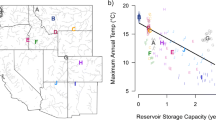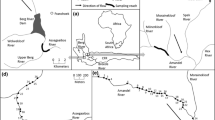Abstract
Climate change projections for the western United States suggest that many regions will experience increasing frequency and severity of droughts. In summer 2015, the Pacific Northwest experienced a drought with early onset of stream low flows, reduced summer discharge, and elevated temperatures. We evaluated population responses of two dominant stream predators—coastal cutthroat trout (Oncorhynchus clarkii clarkii) and coastal giant salamander (Dicamptodon tenebrosus)—across nine Cascade Mountain streams. Drought conditions impacted both trout and salamanders, but their responses differed. Adult trout abundance and biomass were significantly lower in 2015 relative to 2014, a year with discharge and temperature closer to historical norms. Juvenile trout abundance did not differ between years but juveniles were significantly larger in 2015. Salamander abundance and biomass were not significantly different between years but body condition was lower in all nine streams in 2015. Differences in temperature among streams did not explain trout or salamander responses. Habitat was important for trout responses with trout abundance and biomass experiencing smaller declines in systems with more deep pool area. Despite notable short-term drought impacts to trout and salamanders in 2015, populations recovered to pre-drought conditions within two years in all but the smallest stream.






Similar content being viewed by others
References
Arismendi, I., M. Safeeq, S. L. Johnson, J. B. Dunham & R. Haggerty, 2013. Increasing synchrony of high temperature and low flow in western North American streams: double trouble for coldwater biota? Hydrobiologia 712: 61–70.
Baldigo, B. P., D. R. Warren, A. G. Ernst & C. I. Mulvihill, 2008. Response of fish populations to natural channel design restoration in streams of the Catskill Mountains, New York. North American Journal of Fisheries Management 28: 954–969.
Bates, D., M. Maechler, B. Bolker & S. Walker, 2015. Fitting linear mixed-effects models using lme4. Journal of Statistical Software 67: 1–48.
Beechie, T., H. Imaki, J. Greene, A. Wade, H. Wu, G. Pess, P. Roni, J. Kimball, J. Stanford, P. Kiffney & N. Mantua, 2013. Restoring salmon habitat for a changing climate. River research and applications 29: 939–960.
Bendik, N. F. & A. G. Gluesenkamp, 2013. Body length shrinkage in an endangered amphibian is associated with drought. Journal of Zoology 290: 35–41.
Berger, A. M. & R. E. Gresswell, 2009. Factors influencing coastal cutthroat trout (Oncorhynchus clarkii clarkii) seasonal survival rates: a spatially continuous approach within stream networks. Canadian Journal of Fisheries and Aquatic Sciences 66: 613–632.
Brenee’, M. L., S. J. Price & M. E. Dorcas, 2014. Capture probability and survivorship of the Southern Two-Lined Salamander (Eurycea cirrigera) in drought and non-drought conditions. Copeia 2: 366–371.
Carle, F. L. & M. R. Strub, 1978. A new method for rstimating population size from removal data. Biometrics 34: 621–630.
Chapman, D. G., 1951. Some properties of the hypergeometric distribution, with applications to zoological sample censuses. University of California Publications in Statistics 1: 131–160.
Currinder, B., K. K. Cecala, R. M. Northington & M. E. Dorcas, 2014. Response of stream salamanders to experimental drought in the southern Appalachian Mountains, USA. Journal of Freshwater Ecology 29: 579–587.
Ebersole, J. L., W. J. Liss & C. A. Frissell, 2003. Thermal heterogeneity, stream channel morphology, and salmonid abundance in northeastern Oregon streams. Canadian Journal of Fisheries and Aquatic Sciences 60: 1266–1280.
Elliott, J. M., 2000. Pools as refugia for brown trout during two summer droughts: trout responses to thermal and oxygen stress. Journal of Fish Biology 56: 938–948.
Fausch, K. D., 1984. Profitable stream positions for salmonids: relating specific growth rate to net energy gain. Canadian Journal of Zoology 62: 441–551.
Feral, D., M. A. Camann & H. H. Welsh, 2005. Dicamptodon tenebrosus larvae wthin hyporheic zones of intermittent streams in California. Herpetological Review 36: 26–27.
Griswold, B. L., C. J. Edwards & L. C. I. Woods, 1982. Recolonization of macroinvertebrates and fish in a channelized stream after a drought. Ohio Journal of Science 82: 96–102.
Hakala, J. P. & K. J. Hartman, 2004. Drought effect on stream morphology and brook trout (Salvelinus fontinalis) populations in forested headwater streams. Hydrobiologia 515: 203–213.
Hamlet, A. F. & D. P. Lettenmaier, 1999. Effects of climate change on hydrology and water resources in the Columbia River Basin. Journal of the American Water Resources Association 35: 1597–1623.
Hauer, R. F. & G. A. Lamberti (eds.), 2007. Methods in Stream Ecology, 2nd ed. Academica Press (Elsevier), San Diego.
Hilderbrand, R. H. & J. L. Kershner, 2004. Are there differences in growth and condition between mobile and resident cutthroat trout? Transactions of the American Fisheries Society 133: 1042–1046.
James, D. A., J. W. Wilhite & S. R. Chipps, 2010. Influence of drought conditions on brown trout biomass and size structure in the Black Hills, South Dakota. North American Journal of Fisheries Management 30: 791–798.
Kaylor, M. J. & D. R. Warren, 2017. Linking riparian shade and the legacies of forest management to fish and vertebrate biomass in forested streams. Ecosphere 8: e01845.
Kaylor, M. J. & D. R. Warren, 2018. Canopy closure after four decades of post logging riparian forest regeneration reduces cutthroat trout biomass in headwater streams through bottom-up pathways. Canadian Journal of Fisheries and Aquatic Sciences 75: 513–524.
Lake, P. S., 2003. Ecological effects of perturbation by drought in flowing waters. Freshwater Biology 48: 1161–1172.
Leibowitz, S. G., R. L. Comeleo, C. P. Weaver, P. E. Morefield, E. A. Sproles, & J. L. Ebersole. 2014. Hydrologic landscape classification evaluates streamflow vulnerability to climate change in Oregon, USA. Hydrology and Earth System Sciences 18:3367–3392.
Magoulick, D. D. & R. M. Kobza, 2003. The role of refugia for fishes during drought: a review and synthesis. Freshwater Biology 48: 1186–1198.
Mantua, N., I. Tohver & A. Hamlet, 2010. Climate change impacts on streamflow extremes and summertime stream temperature and their possible consequences for freshwater salmon habitat in Washington State. Climatic Change 102: 187–223.
Matthews, K. R., N. H. Berg, D. L. Azuma & T. R. Lambert, 1994. Cool water formation and trout habitat use in a deep pool in the Sierra Nevada, California. Transactions of the American Fisheries Society 123: 549–564.
May, C. L. & D. C. Lee, 2004. The relationships among in-channel sediment storage, pool depth, and summer survival of juvenile salmonids in Oregon Coast Range streams. North American Journal of Fisheries Management 24: 761–774.
Moore, K. M. S. & S. V. Gregory, 1988a. Habitat utilization and ecology of cutthroat trout fry (Salmo Clarki) in Cascade Mountain streams. Canadian Journal of Fisheries and Aquatic Sciences 45: 1921–1930.
Moore, K. M. S. & S. V. Gregory, 1988b. Response of young-of-the-year cutthroat trout to manipulation of habitat structure in a small stream. Transactions of the American Fisheries Society 117: 162–170.
Mote, P. W., E. A. Parson, A. F. Hamlet, W. S. Keeton, D. Lettenmaier, N. Mantua, E. L. Miles, D. W. Peterson, D. L. Peterson, R. Slaughter & A. K. Snover, 2003. Preparing for climatic change: The water, salmon, and forests of the Pacific Northwest. Climatic Change 61: 45–88.
Mote, P. W., D. E. Rupp, S. Li, D. J. Sharp, F. Otto, P. F. Uhe, M. Xiao, D. P. Lettenmaier, H. Cullen & M. R. Allen, 2016. Perspectives on the causes of exceptionally low 2015 snowpack in the western United States. Geophysical Research Letters 43: 980–988.
Nussbaum, R. A. & G. W. Clothier, 1973. Population structure, growth, and size of larval Dicamptodon ensatus. Northwest Science 47: 218–227.
Penaluna, B. E., J. B. Dunham, S. F. Railsback, I. Arismendi, S. L. Johnson, R. E. Bilby, M. Safeeq & A. E. Skaugset, 2015. Local variability mediates vulnerability of trout populations to land use and climate change. PLoS ONE 10: 1–20.
Power, M. E., J. R. Holomuzki & R. L. Lowe, 2013. Food webs in Mediterranean rivers. Hydrobiologia 719: 119–136.
Price, S. J., R. A. Browne & M. E. Dorcas, 2012. Resistance and resilience of a stream salamander to supraseasonal drought. Herpetologica 68: 312–323.
R Core Team, 2015. R: a language and environment for statistical computing. R Foundation for Statistical Computing, Vienna.
Roni, P., 2002. Habitat use by fishes and pacific giant salamanders in small western Oregon and Washington streams. Transactions of the American Fisheries Society 131: 743–761.
Roni, P., K. Hanson & T. Beechie, 2008. Global review of the physical and biological effectiveness of stream habitat rehabilitation techniques. North American Journal of Fisheries Management 28: 856–890.
Sheldon, K. A. (2010). Season-specific survival and growth rates of coastal cutthroat trout across a gradient of stream sizes in southwestern British Columbia (Doctoral dissertation, University of British Columbia).
Sproles, E. A., A. W. Nolin, K. Rittger & T. H. Painter, 2013. Climate change impacts on maritime mountain snowpack in the Oregon Cascades. Hydrology and Earth System Sciences 17: 2581–2597.
Van Deventer, J. S. & W. S. Platts, 1989. Microcomputer software system for generating population statistics from electrofishing data—user’s guide for MicroFish 3.0. U.S. Forest Service, Ogden, UT.
VerWey, B. J., M. J. Kaylor, T. S. Garcia & D. R. Warren, 2018. Impacts of a severe drought on cutthroat trout in a western Oregon headwater ecosystem. Northwestern Naturalist 99: 209–222.
Walters, A. W., 2016. The importance of context dependence for understanding the effects of low-flow events on fish. Freshwater Science 35: 216–228.
Warren, D. R. & C. E. Kraft, 2003. Brook trout (Salvelinus fontinalis) response to wood removal from high-gradient streams of the Adirondack Mountains (N.Y., U.S.A.). Canadian Journal of Fisheries and Aquatic Sciences 60: 379–389.
Werner, E. E., 1986. Amphibian metamorphosis: growth rate, predation risk, and the optimal size at transformation. The American Naturalist 128: 319–341.
Williams, J. E., A. L. Haak, H. M. Neville & W. T. Colyer, 2009. Potential consequences of climate change to persistence of cutthroat trout populations. North American Journal of Fisheries Management 29: 533–548.
Williams, J. E., H. M. Neville, A. L. Haak, W. T. Colyer, W. J. Seth & S. Bradshaw, 2015. Climate change adaptation and restoration of- western trout streams: opportunities and strategies. Fisheries 40: 304–317.
Acknowledgements
We thank Emily Heaston, Gavin Jones, Christopher Kopet, Katherine Pospisil and Emily Purvis for their extensive and committed help in conducting fieldwork. This research was supported by a National Science Foundation Graduate Research Fellowship (Grant No. 1314109-DGE awarded to MJ Kaylor), the US Department of Agriculture National Institute of Food and Agriculture McIntire Stennis program (Award 1009738), and the HJ Andrews Experimental Forest research program (which is funded by the National Science Foundation’s Long-Term Ecological Research Program (DEB 1440409), US Forest Service Pacific Northwest Research Station, and Oregon State University). All animal collections were conducted in compliance with Oregon State University’s Animal Care and Use Committee (Permit No. 4439).
Author information
Authors and Affiliations
Corresponding author
Additional information
Handling editor: Eric Larson
Electronic supplementary material
Below is the link to the electronic supplementary material.
Rights and permissions
About this article
Cite this article
Kaylor, M.J., VerWey, B.J., Cortes, A. et al. Drought impacts to trout and salamanders in cool, forested headwater ecosystems in the western Cascade Mountains, OR. Hydrobiologia 833, 65–80 (2019). https://doi.org/10.1007/s10750-019-3882-2
Received:
Revised:
Accepted:
Published:
Issue Date:
DOI: https://doi.org/10.1007/s10750-019-3882-2




